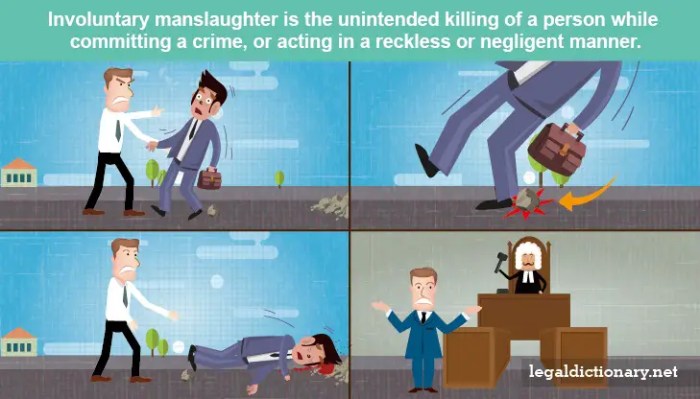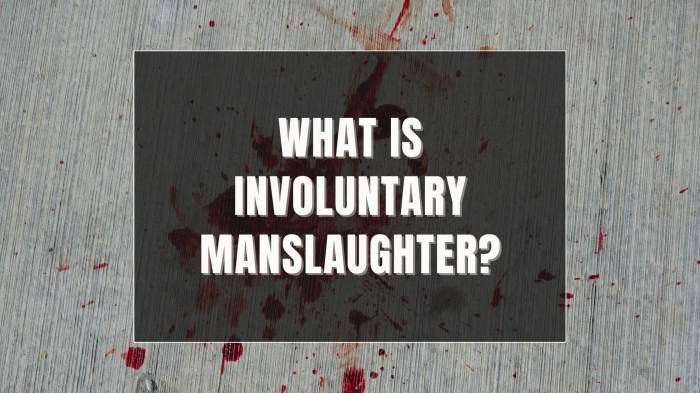The difference between involuntary and voluntary manslaughter is a crucial distinction in criminal law, with significant implications for intent, consequences, and sentencing. This essay delves into the legal definitions, intent requirements, common examples, and potential defenses of these two types of manslaughter, providing a comprehensive analysis of their distinct characteristics.
Involuntary manslaughter, characterized by a lack of malicious intent, typically results from recklessness or negligence. Voluntary manslaughter, on the other hand, involves an intentional killing committed under the influence of sudden passion or heat of blood, often provoked by extreme emotional distress.
Legal Definitions: Difference Between Involuntary And Voluntary Manslaughter
Involuntary manslaughter is a homicide that occurs without the intent to kill or cause serious bodily harm. It is typically caused by recklessness or negligence. Voluntary manslaughter, on the other hand, is a homicide that occurs when the defendant intended to kill or cause serious bodily harm, but did so in the heat of passion or sudden provocation.
Intent and Knowledge
In involuntary manslaughter, the defendant does not have the intent to kill or cause serious bodily harm. However, they may be aware of the risk of death or serious bodily harm and act recklessly or negligently. In voluntary manslaughter, the defendant intends to kill or cause serious bodily harm, but does so in the heat of passion or sudden provocation.
This means that the defendant’s intent is not premeditated, but rather is a result of a sudden loss of control.
Compare and Contrast Intent and Knowledge Requirements
The key difference between involuntary and voluntary manslaughter is the intent of the defendant. In involuntary manslaughter, the defendant does not intend to kill or cause serious bodily harm, while in voluntary manslaughter, the defendant does. This difference in intent is reflected in the potential consequences of each crime.
Examples

Involuntary Manslaughter
- A driver who runs a red light and kills a pedestrian
- A doctor who prescribes the wrong medication, resulting in the patient’s death
- A parent who leaves a child unattended in a hot car, resulting in the child’s death
Voluntary Manslaughter
- A person who kills another person in a fit of rage
- A person who kills another person in self-defense, but uses excessive force
- A person who kills another person in the heat of passion, after being provoked by the victim
Comparison of Examples, Difference between involuntary and voluntary manslaughter
| Involuntary Manslaughter | Voluntary Manslaughter |
|---|---|
| No intent to kill or cause serious bodily harm | Intent to kill or cause serious bodily harm |
| Typically caused by recklessness or negligence | Typically caused by sudden loss of control |
| Examples: running a red light, prescribing the wrong medication | Examples: killing in a fit of rage, killing in self-defense with excessive force |
Consequences

The potential consequences of involuntary manslaughter are less severe than the potential consequences of voluntary manslaughter. This is because involuntary manslaughter is not considered to be as serious a crime as voluntary manslaughter. The consequences of involuntary manslaughter can include imprisonment, probation, and fines.
The consequences of voluntary manslaughter can include imprisonment, life imprisonment, and the death penalty.
Compare and Contrast Consequences
The key difference between the consequences of involuntary and voluntary manslaughter is the severity of the potential punishment. Involuntary manslaughter is typically punished less severely than voluntary manslaughter because it is not considered to be as serious a crime. This is reflected in the range of potential punishments for each crime.
Defenses
There are a number of defenses that can be raised to a charge of involuntary manslaughter. These defenses include self-defense, accident, and lack of intent. There are also a number of defenses that can be raised to a charge of voluntary manslaughter.
These defenses include self-defense, provocation, and diminished capacity.
Compare and Contrast Defenses
The key difference between the defenses to involuntary and voluntary manslaughter is the availability of the defense of provocation. Provocation is a defense that is only available to a charge of voluntary manslaughter. This is because provocation is a mitigating factor that can reduce the defendant’s culpability for the crime.
Sentencing

The sentencing for involuntary manslaughter is determined by a number of factors, including the defendant’s criminal history, the circumstances of the crime, and the impact of the crime on the victim’s family. The sentencing for voluntary manslaughter is determined by a number of factors, including the defendant’s criminal history, the circumstances of the crime, and the impact of the crime on the victim’s family.
Compare and Contrast Sentencing Considerations
The key difference between the sentencing considerations for involuntary and voluntary manslaughter is the availability of the defense of provocation. Provocation is a mitigating factor that can reduce the defendant’s culpability for the crime, and can therefore lead to a less severe sentence.
General Inquiries
What is the key difference between involuntary and voluntary manslaughter?
The primary distinction lies in the presence or absence of malicious intent. Involuntary manslaughter lacks malicious intent, while voluntary manslaughter involves an intentional killing committed under mitigating circumstances.
What are common examples of involuntary manslaughter?
Examples include deaths resulting from reckless driving, medical negligence, or accidental shootings.
What is the typical defense for voluntary manslaughter?
The most common defense is provocation, where the defendant acted in the heat of passion or sudden emotional distress caused by the victim’s actions.